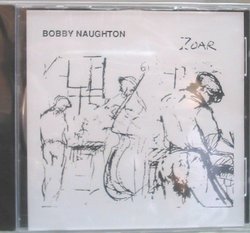| All Artists: Bobby Naughton Title: Zoar Members Wishing: 0 Total Copies: 0 Release Date: 4/4/2006 Genre: Jazz Style: Number of Discs: 1 SwapaCD Credits: 1 UPC: 634479284519 |
Search - Bobby Naughton :: Zoar
CD DetailsSimilar CDs
|
CD ReviewsBobby Naughton, Mallet Master. C. Rich | 11/27/2009 (5 out of 5 stars) "From Brilliant Corners, A Boston Jazz Blog.
I have long been a fan of this most African of instruments. From the balaphone of the West African forest lands it spun into marimba, xylophone and vibes. Bobby Naughton has to be one of the most under appreciated mallet masters of our time. It will resound to the credit of the Connecticut Commission on the Arts that someone there saw fit to fund this recording on November 15th, 1983. And it was pretty cool of Yale to provide a chapel for the recording. He recently launched his own website, where you can purchase his work directly from him and one of the joys of having this sort of blog is that luminaries of this caliber sometimes come out of the cyber woodwork to participate in it. His site offers this bit of background for the unfamiliar. "Bobby Naughton is self-taught as a performer and composer. After playing in rock-and-roll groups he took up the vibraphone in 1966, and in the late 1960s played with Perry Robinson, Sheila Jordan, and others. He continued to work intermittently with Robinson while recording as a leader from 1969 on his own label, Otic; in 1971 he wrote a score for Hans Richter's silent film Everyday (1929). He played with the Jazz Composer's Orchestra in 1972 and Leo Smith (from the mid 1970s), and joined the Creative Music Improvisers Forum in New Haven, Connecticut. Naughton's vibraphone playing, like that of Gunter Hampel, emphasizes the instrument's role in group improvisation rather than its possibilities as a solo vehicle. He plays fluently with four sticks, exploits the vibraphone's overtones, and sometimes controls manually the instrument's vanes (which vary its sound intensity). His piano playing (which may be heard on the first of his own albums) has a melodic strength and terseness reminiscent of Paul Bley." Roger Dean, The New Grove Dictionary of Jazz, copyright Macmillan Reference Ltd 1988 Pretty impressive, no? So much of jazz biz is a yucky arbitrary thing. Joe Public with some vague handle on the idiom is far more likely to know of the soporific Gary Burton who is the sonic equivalent to a whitebread tuna sandwich way overloaded with mayo.And Zoar is proof that jazz deserves to be examined in some depth to avoid the fate of mistaking it for Weather Channel Forecast background music, the new and proper home for Pat Metheney. 1. Pomperaug Diversions. (Bobby Naughton). This hints at a march. Joe Fonda has an ability to coax low end horn sounds from an upright bass that can stun and surprise as if the thing turned into a tuba. Bobby is in his own distinct class among mallet masters with a crisp meticulous staccato method and some mildly miraculous tone bending. As a composition, Pomperaug Diversions has some echo of 'futuristic' music envisioned by film composers such as Raymond Scott.Randy Kaye readily demonstrates a mastery of dynamic range control with kit work well fit to his trio colleagues. 2. Vashkar. (Carla Bley). Carla Bley's composition is far more striking in an austere trio reading then one might find in the more color loaded ensembles she generally uses. Joe Fonda signals the start with a few fat bass tones.The piece has the reflective quietude of a still forest pond in a dreamscape. Bobby makes deft switches from short legato phrase segments to his more challenging precision of tight tiny tones wrapped in equally tiny silences. Randy wraps it in well fit brush work subtleties and Joe Fonda rises from the ensemble texture toward the last third with a bracing pattern of ear opening double stop plucks contrasted by fleet note runs also using space with confidence and finesse. 3. RPDD. (Ornette Coleman). The trio tackles Ornette in spirit and to the letter in an exuberant sprint with seemingly effortless negotiation of Coleman's signature melodic angularity. Colemanisms readily rise from the vibes and Joe handles his bass with a jaunty exuberance suggesting this is the sort of thing these guys do for fun the way kids do cannonballs off the diving board in a swelter day swimming pool. 4. Shepaug Strut. (Bobby Naughton). Mr. Naughton brings the Strut to life with a few big tones. It has a searching quality about it with a commendable blend of a march and a nocturne as it does make me think of sunsets and pondering days ahead.The Fonda contribution is a tempo contrast to create an engaging rhythmic tension marked by more examples of a distinct love of tone bending as if he had a whammy bar. The vibe tones float in roomy silences and Mr. Kaye skillfully creates the percussive biome for it all to come alive. 5. Zoar. (Bobby Naughton). Here we find a cerebral composition design balanced by a visceral delivery informed by a big heart. Thus the three elements of creativity are humming together well. It bounces somewhat and could almost be a subtle space age allegory to something like"Bouncing With Bud" while having no melodic or structural similarity whatever. It is an ambitious composition well fulfilled by all three participants and is a good pick for a title track. It is a particularly good spot to hear the versatility and imagination of Randy Kaye as he gets a pretty fat bit of time/space to run a solo. His approach is to make the hat/cymbal/snare core a consistent center for free time pulsed excursions all over the kit. 6. Goodbye. (Gordon Jenkins). A wistful beautiful closer once used to end Benny Goodman shows from the Broadway and Film composer Gordon Jenkins. Mr. Naughton gets it out of it's swing era zoot suit and gives it a modern outfit, spare and comfortable that allows it to shine in a newer day. I bet it has some resonance with the trio's childhood and a connection to things liked by parents honored well. Mr. Fonda is strikingly elegiac here and there is a stirring yearning to it all." |




